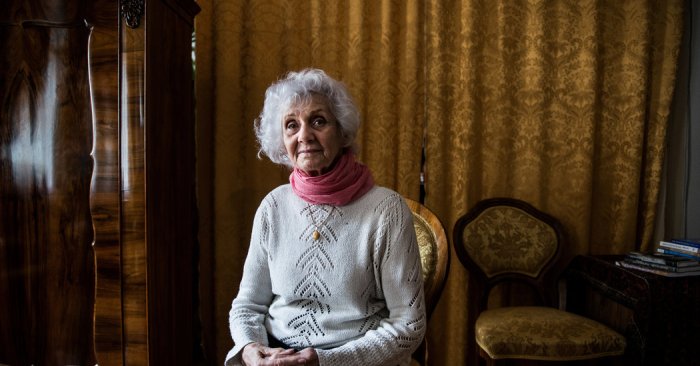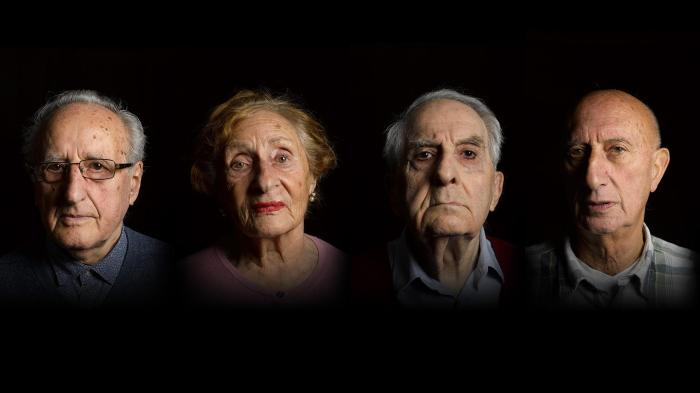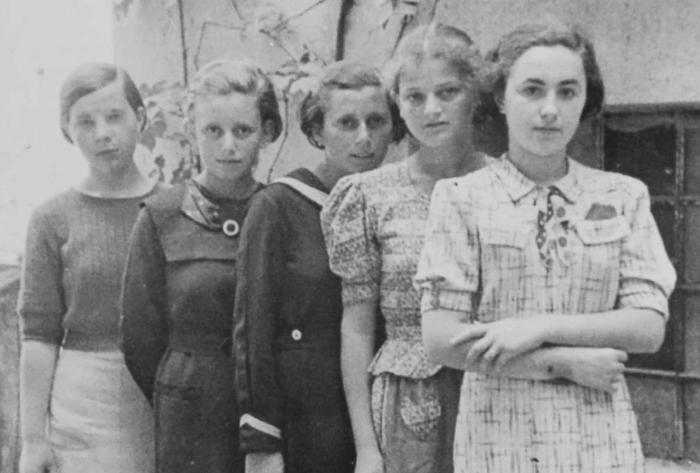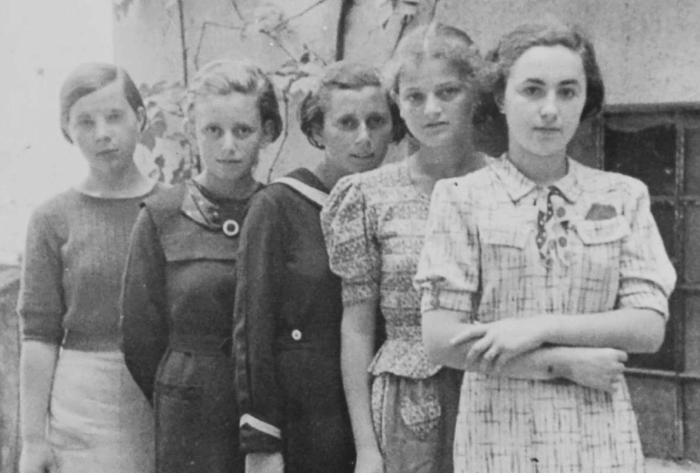Imagine carrying the weight of history, not just in your mind, but in your very being. That’s the reality for second-generation Holocaust survivors. They didn’t witness the horrors firsthand, but the trauma of their parents’ experiences seeped into their lives, shaping their identities and leaving an indelible mark on their souls.
This is a story of resilience, of navigating a complex world where the past refuses to stay buried.
This exploration dives deep into the emotional landscape of inherited trauma, examining how the Holocaust’s shadow continues to cast its influence on generations after. We’ll explore the unique challenges faced by these individuals, their struggles with identity and belonging, and the remarkable ways they find strength and healing in the face of adversity.
The Weight of History

The Holocaust, a horrific event in human history, has left an indelible mark on the world, particularly on the lives of those who survived and their descendants. While the physical scars of the Holocaust have faded, the emotional and psychological wounds have been passed down through generations, creating a complex and enduring legacy of trauma.
This section delves into the concept of intergenerational trauma, specifically focusing on the impact of the Holocaust on second-generation survivors, examining the emotional, psychological, and behavioral effects of inherited trauma.
The Intergenerational Transmission of Trauma
The intergenerational transmission of trauma refers to the phenomenon where the experiences of trauma in one generation can impact subsequent generations. This process can occur through various mechanisms, including:
- Direct Exposure:Second-generation survivors may have witnessed their parents’ struggles, heard their stories, or even been directly involved in their care. This exposure to trauma can have a profound impact on their emotional development.
- Genetic Predisposition:Research suggests that trauma can alter the expression of genes, making individuals more susceptible to mental health issues. These genetic changes can be passed down to subsequent generations, increasing the risk of trauma-related conditions.
- Environmental Factors:The environment in which a child is raised can also contribute to the transmission of trauma. For example, a family environment characterized by fear, anxiety, and avoidance behaviors can create a breeding ground for intergenerational trauma.
Emotional, Psychological, and Behavioral Effects of Inherited Trauma
Living with inherited trauma can have a significant impact on the emotional, psychological, and behavioral well-being of second-generation survivors. These effects may manifest in various ways, including:
- Anxiety and Depression:Inherited trauma can increase the risk of developing anxiety disorders, such as generalized anxiety disorder, panic disorder, and post-traumatic stress disorder (PTSD). Similarly, depression is another common mental health condition associated with intergenerational trauma.
- Survivor Guilt:Second-generation survivors may experience survivor guilt, feeling a sense of unease or guilt for having been spared from the horrors their parents endured. This feeling can stem from a sense of responsibility for the suffering of their family members or a belief that they should have shared in their parents’ experiences.
- Relationship Difficulties:Inherited trauma can also impact relationships. Second-generation survivors may have difficulty forming and maintaining healthy relationships due to trust issues, communication problems, or a fear of intimacy.
- Physical Health Problems:Research has shown a correlation between trauma and physical health problems. Inherited trauma can increase the risk of developing chronic health conditions, such as heart disease, diabetes, and autoimmune disorders.
Personal Accounts and Research Findings
“I grew up with a sense of constant unease. My parents never talked about the Holocaust, but their silence spoke volumes. I felt like I was walking on eggshells, afraid to ask questions or express my emotions. It was as if I was living in a shadow of their trauma.”
Sarah, a second-generation survivor
Sarah’s account highlights the complexities of living with inherited trauma. The silence and avoidance behaviors of her parents created an atmosphere of fear and uncertainty, contributing to her own emotional struggles.Research conducted by the Holocaust Survivors’ Children Network (HSCN) has revealed that second-generation survivors are more likely to experience anxiety, depression, and PTSD compared to the general population.
The HSCN’s findings underscore the significant impact of intergenerational trauma on the mental health of Holocaust descendants.
You know, sometimes it’s like trying to understand a song you love but can’t quite grasp the lyrics. That’s kind of how it feels to explore the legacy of the Holocaust through the eyes of a second-generation survivor. It’s like trying to decipher a cryptic message, one that echoes in the silence between the lines.
It’s a story told in whispers and shadows, in the unspoken anxieties and fears passed down through generations. But sometimes, listening to a different kind of music, like the raw, honest stories of Bob Dylan’s band members in Pledging My Time Conversations with Bob Dylan Band Members , helps me connect with the raw emotion of those stories.
It reminds me that even in the face of unimaginable pain, there’s still beauty, resilience, and a yearning for connection. And maybe, just maybe, by understanding the past, we can find a way to heal the wounds that still linger in the present.
Navigating Identity and Belonging

The children of Holocaust survivors, often referred to as the second generation, face a unique set of challenges in shaping their identities. Their parents’ experiences cast a long shadow, impacting their sense of self, their connection to their heritage, and their place in the world.
Navigating these complexities requires a delicate balance between honoring the past and forging their own path.
The Intergenerational Impact of Trauma
The trauma experienced by Holocaust survivors is not confined to their own lives. It reverberates through generations, leaving an indelible mark on their children. Second-generation survivors often carry the weight of their parents’ unspoken pain, their anxieties, and their fears.
Imagine the weight of history, the echoes of trauma passed down through generations. “A Life Inherited: Unraveling the Trauma of a Second-Generation Holocaust Survivor” explores the profound impact of such experiences, and sometimes, finding solace in the simple act of creativity can be a lifeline.
For those seeking a way to channel those complex emotions, Mandala Color By Number A Color By Number Mandalas Coloring Book for Adults with Beautiful 50 Designs for Stress Relief and Creativity offers a therapeutic escape, allowing you to focus on intricate patterns and vibrant colors, creating a personal sanctuary amidst the chaos.
Understanding the legacy of trauma can be a journey, and sometimes, finding moments of peace through artistic expression can make all the difference.
They may struggle with feelings of guilt, shame, and survivor’s guilt, even though they themselves did not experience the horrors of the Holocaust. This intergenerational transmission of trauma can manifest in various ways, including:
- Mental health issues:Second-generation survivors are at a higher risk of developing mental health conditions such as anxiety, depression, and post-traumatic stress disorder (PTSD). These conditions can be attributed to the impact of their parents’ trauma on their upbringing and their own emotional well-being.
- Identity confusion:The Holocaust fundamentally altered the lives of survivors, forcing them to confront their own mortality, their sense of belonging, and their faith. These existential questions can be passed down to their children, leading to identity confusion and a struggle to define themselves outside of their parents’ experiences.
- Communication challenges:The trauma of the Holocaust can make it difficult for survivors to talk about their experiences. This can create a communication barrier between parents and children, making it challenging for second-generation survivors to understand and process their parents’ pain.
Cultural and Societal Expectations
Second-generation survivors often face conflicting expectations from both their families and society. On one hand, they are expected to honor their parents’ legacy and carry the torch of remembrance. On the other hand, they are also expected to integrate into mainstream society and forge their own identities.
Yo, listen up! “A Life Inherited” is a raw, real story about the impact of the Holocaust on the next generation. It’s a wild ride, man, diving deep into the emotional baggage that comes with family trauma. If you wanna hear this powerful tale, Download And Listen Here.
It’s a story that’ll stick with you, bro. “A Life Inherited” is a must-listen for anyone who wants to understand the ripple effects of history.
This duality can create a sense of alienation and a feeling of not fully belonging anywhere.
“I felt like I was living in two worlds,” says a second-generation survivor. “One world was the world of my parents, with its constant reminders of the past. The other world was the world of my peers, who had no understanding of what I was going through.”
Navigating Identity and Belonging: Finding Meaning and Connection
Despite the challenges, second-generation survivors have found ways to navigate these complexities and forge their own identities. Many have turned to art, literature, and activism as outlets for processing their experiences and connecting with their heritage.
- Art and Literature:Artists and writers have used their creative talents to explore the themes of trauma, identity, and memory. Their work often serves as a bridge between generations, offering a glimpse into the inner world of both survivors and their children.
- Activism:Second-generation survivors have also become active in promoting Holocaust education and remembrance. They believe that by sharing their stories and the stories of their parents, they can help to prevent future atrocities and ensure that the lessons of the Holocaust are never forgotten.
Finding Healing and Resilience
The journey of a second-generation Holocaust survivor is a complex one, often marked by inherited trauma that can manifest in various ways. These individuals carry the weight of history, navigating identity and belonging while grappling with the emotional and psychological scars of their parents’ experiences.
Finding healing and resilience becomes a crucial aspect of their journey, requiring them to confront the past, understand its impact, and develop strategies for coping and growth.
Strategies for Coping and Growth
Coping with inherited trauma can be a challenging process, but it’s essential to remember that healing is possible. Second-generation survivors often utilize a variety of strategies to manage their emotional and psychological well-being.
- Therapy:Seeking professional help from therapists specializing in trauma and intergenerational trauma can provide a safe space to process emotions, develop coping mechanisms, and gain insights into the impact of inherited trauma. Therapists can help individuals understand their experiences, develop healthy boundaries, and build resilience.
- Support Groups:Connecting with others who share similar experiences can provide a sense of community and validation. Support groups offer a platform to share stories, learn from others’ journeys, and receive emotional support. These groups create a space where individuals can feel understood and less alone in their struggles.
- Creative Expression:Engaging in creative activities like writing, painting, music, or dance can be a powerful outlet for processing emotions and expressing oneself. Art can serve as a cathartic release, allowing individuals to explore their feelings and find meaning in their experiences.
The Role of Forgiveness, Acceptance, and Self-Compassion
While forgiveness, acceptance, and self-compassion may seem challenging, they play a crucial role in the healing process.
It’s tough to imagine the weight of history carried by a second-generation Holocaust survivor, but sometimes, a simple act of self-care can make a world of difference. For those struggling with the emotional burdens of inherited trauma, coloring can be a surprisingly powerful tool for grounding and relaxation.
Check out the Simple Large Print Coloring Book for Adults with Relaxing Flowers 40 Easy Big and Beautiful Flower Designs for Adults Seniors and Beginners. (Island Smiles Large Print Coloring) , designed with seniors and beginners in mind, offering a calming escape from the complexities of a life shaped by history.
Maybe it’s a small step, but sometimes, a little color can help a survivor find their own peace.
- Forgiveness:Forgiveness doesn’t mean condoning the past; it’s about releasing the anger, resentment, and bitterness that can hold us captive. Forgiving those who have caused harm, including ancestors, can be a step towards emotional liberation and peace.
- Acceptance:Accepting the reality of the past, including the trauma experienced by parents and its impact on their lives, is essential for moving forward. Acceptance allows individuals to acknowledge the truth without judgment and to focus on healing and growth.
- Self-Compassion:Treating oneself with kindness, understanding, and acceptance is vital. Self-compassion helps individuals recognize that they are not to blame for the trauma they have inherited and that they deserve to heal and thrive.
Stories of Resilience and Growth
Despite the challenges of inherited trauma, many second-generation survivors have found resilience and growth.
“I spent years feeling like I was carrying a heavy burden, but through therapy and support groups, I learned to acknowledge the impact of my parents’ experiences without letting it define me. I’ve found ways to honor their memory while creating my own path.”
Sarah, a second-generation survivor.
“Forgiving my parents for their struggles and the ways they coped with trauma wasn’t easy, but it was a necessary step towards healing. It allowed me to release the anger and resentment I carried and to move forward with compassion and understanding.”
David, a second-generation survivor.
These stories highlight the strength and resilience of individuals who have faced the challenges of inherited trauma head-on. Their journeys demonstrate the power of healing, growth, and the possibility of creating a brighter future despite the weight of history.
Final Summary

Unraveling the trauma of a second-generation Holocaust survivor isn’t just about understanding the past; it’s about acknowledging the enduring impact of history on the present. It’s a testament to the human spirit’s capacity for resilience, the power of healing, and the importance of finding meaning in the face of unimaginable pain.
By shedding light on their experiences, we gain a deeper understanding of the lasting legacy of the Holocaust and the enduring strength of the human spirit.
Q&A
What are some common symptoms of inherited trauma?
Inherited trauma can manifest in various ways, including anxiety, depression, difficulty forming relationships, survivor guilt, and a heightened sense of fear or vulnerability.
How can second-generation survivors find support and resources?
There are many organizations and resources available to help second-generation survivors cope with inherited trauma. These include therapy, support groups, and educational programs. It’s important to seek out support and connect with others who understand their unique experiences.
What are some examples of creative expression that can help in healing?
Art, writing, music, and other forms of creative expression can be powerful tools for processing trauma and finding healing. These outlets allow individuals to express their emotions, explore their experiences, and connect with others who understand their pain.

